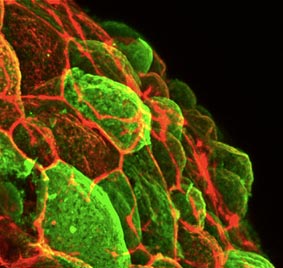November 10, 2013
Healing powers
Carl-Philipp Heisenberg group detects mechanism in cell division relevant for closing wounds

How do cells spread to cover and close a wound? A team of researchers led by IST Austria Professor Carl-Philipp Heisenberg, including first author Pedro Campinho, PhD student in the Heisenberg group, publishes new insights into epithelial cell spreading in the current online edition of Nature Cell Biology.
Spreading of the epithelial cell layer is fundamental for epithelial closure and wound healing, as well as for embryonic development. The challenge presented here is that the cell layer needs to increase in surface area, but nevertheless maintain its integrity. For their research, the Heisenberg’s team used the process of epiboly in zebrafish development to model cell spreading. Epiboly is a step in the embryonic development of zebrafish during which a thin epithelial cell layer spreads over the entire cell sphere within a space of only 6 hours. This fast cell spreading comes along with a rapid increase of the epithelium’s surface area, and a build-up of tension in the cell layer.
The researchers found a new mechanism required for releasing the built-up tension, namely orienting the direction in which cells divide through mechanical tension. They show that controlling this mechanism requires two processes, namely cell elongation and the correct alignment of the mitotic spindle, the cell’s control center for division. The tension in the epithelium elongates the cells. As cells usually orient their spindle along the longest axis, this results in cells dividing perpendicular to the long axis. In addition, myosin II activity aligns the mitotic spindle with the axis of tension.
In the absence of tension-oriented cell division, tissue tension is increased, and the researchers observed an ectopic fusion of cells as an alternative mechanism of tension release. They conclude that cell-division orientation by tension is a key mechanism for limiting the tension arising during epithelial spreading, thereby ensuring tissue integrity and tissue spreading during epiboly.



